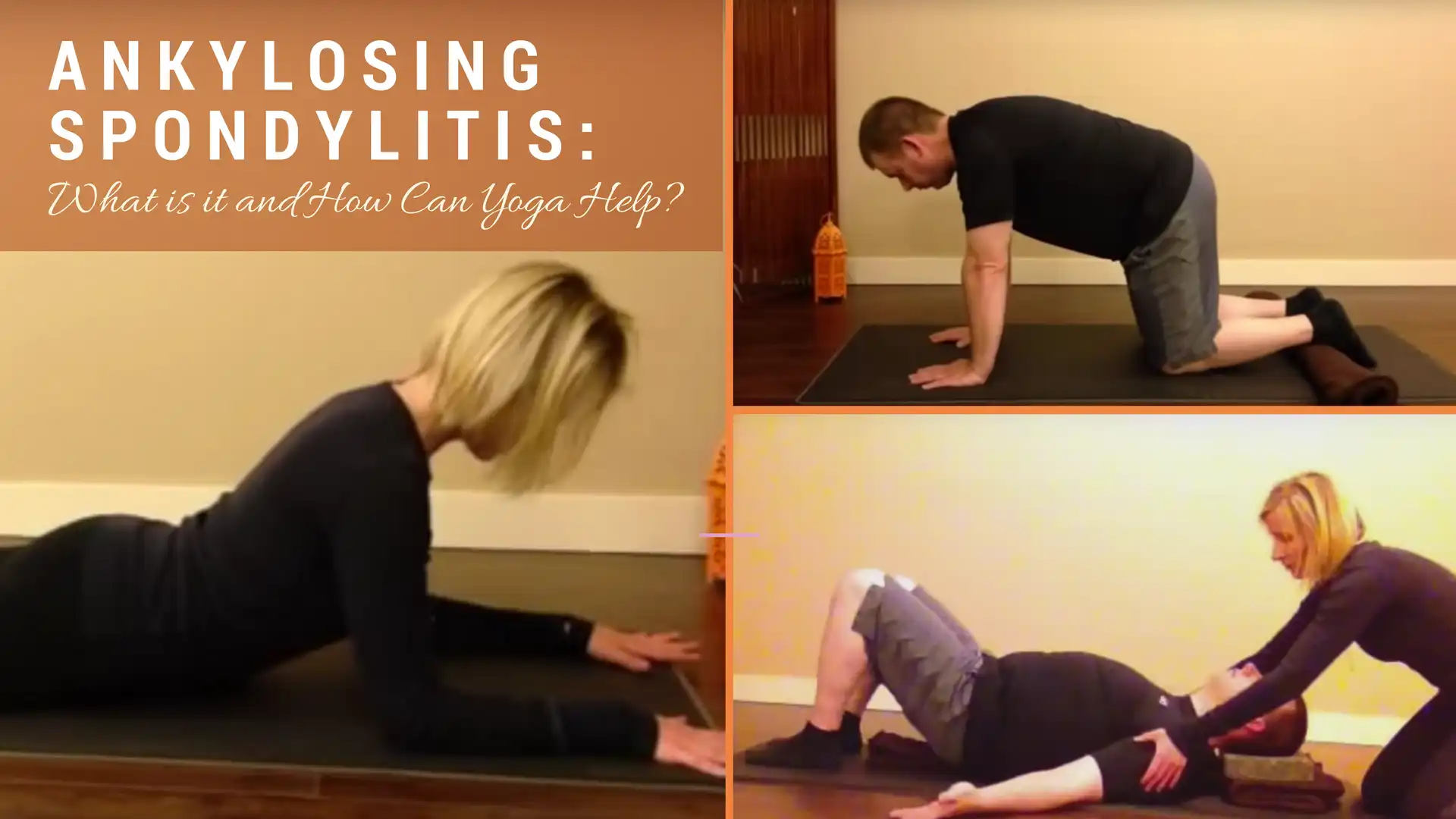Ankylosing Spondylitis: What Is It and How Can Yoga Help?

I recently had a physical therapist colleague ask me for advice about some yoga poses that may help her client who has ankylosing spondylitis.
What is Ankylosing Spondylitis?
Ankylosing spondylitis is a chronic inflammation of the joints of the spine and is considered to be an autoimmune disease.
Symptoms include pain in the SI joint, spine and other joints, reduced chest/rib mobility or expansion, resulting in less efficient breathing patterns, fatigue, osteopenia/osteoporosis, and digestion problems (IBS). For reasons we do not know (although, there are speculation and theories) the body receives a “trigger” that tells it to “attack” itself. The body can potentially then go into “repair” mode, causing excess bone formation which explains the fusion of joints that is sometimes seen in advanced ankylosing spondylitis.
Can Yoga Help Ankylosing Spondylitis?
There is evidence that yoga may be able to help with ankylosing spondylitis, but it is not a panacea and, as with anything, very much depends on the particular situation. I explained to my colleague that there are certainly some poses I would share with her that could potentially address some of the general commonalities of the symptoms of AS, but I also explained that I thought it was important for her and her client to understand that:
1) Therapeutic yoga is so much more than prescribing poses for a particular dysfunction or special population
and
2) The phrase, “yoga for ankylosing spondylitis” (or any diagnosis) tends to suggest, in my opinion, that we are using a reductionist approach and falling into the trap of treating/addressing a diagnosis instead of a person who is a living, breathing, moving, thinking, feeling and reacting being that is connected to and affected by the surrounding environment; a being that consists of complex systems and layers, each one influencing the other, including the nervous systems, digestive system, musculoskeletal system, hormonal system, immune system, and integumentary system, as well as emotional, social and spiritual layers, just to name a few.
That being said, there are certainly some common “physiotherapy exercises + yoga” methods that can be used for people looking to optimize spinal and rib mobility and alignment, maximize breath pattern, improve pain management, and/or calm the nervous system. But I suppose that would be a really long title for this article.
I can appreciate how it’s easier to simply say “yoga for _______ (fill in the blank with a diagnosis),” and I’d assume we all understand that we’re making generalizations that aren’t to be used as prescription or individual therapy, but are simply outlining some potentially valuable guidelines in order to help people.
I don’t believe these types of titles we (including me) continuously use for our workshops, webinars, books, videos, etc., are accurate titles for what we as yoga therapists offer our clients. I’m trying to be more creative and honest with my titles; I hope my colleagues in this industry will do the same. I think it’s important to be clear.
So, for the record, this article is not meant to be interpreted as “Yoga for Ankylosing Spondylitis.” I just want to be clear that I strongly believe in “yoga for the individual person” and his or her unique physical, mental, emotional, energetic and spiritual state, which is constantly changing and responding.
Keeping this in mind, I’d like to share the response to my colleague’s request!
Ways Yoga Can Help Relieve Ankylosing Spondylitis Symptoms
-
reduce the chances or severity of secondary complications as above
-
help improve management of symptoms as above
-
maintain and optimize joint mobility and alignment
-
optimize muscle health and function
-
maximize efficient breathing patterns (which can help move better)
-
improve self management of pain
-
increase self-efficacy
-
optimize feelings of joy, pleasure & gratitude
-
maximize functional capacity and quality of life
One of my yoga students, who happens to also have ankylosing spondylitis, was willing to be a model to demonstrate some “physio + yoga” techniques that I chose for this case.
Certain yoga poses, movements and breathing methods can help address posture, alignment, mobility and stability as well as potentially address the energetic layer (combat fatigue, improve sleep) or produce a calming effect on the nervous system which can help with such things as pain management.
Mindfulness or meditation practices such as awareness, visualization or other methods of focus can also potentially help with pain management, change the pain experience, and perhaps even reduce the chance that the genes associated with inflammation are expressed (Kaliman et al, 2014).
There is currently no formal test to actually diagnose ankylosing spondylitis. The Arthritis Society states that although most people that have AS carry the HLA-B27 gene; that most people with the HLA-B27 gene do not get ankylosing spondylitis. So, just because you have the gene, doesn’t mean you will get AS. The Arthritis Society states: “in fact, only a very small number of people with this gene will ever develop ankylosing spondylitis.”
If your physician suspects you have ankylosing spondylitis, it is a good idea to get a referral to a rheumatologist to help guide and manage your care.
PhysioYoga can be used as a valuable and beneficial complementary therapy to one’s current medical treatment. I highly recommend following and continuing with your medical treatment plan, in addition to finding a physical therapist or health care professional in your area that is trained in integrating yoga therapy and nutritional therapy into his or her treatment sessions.
Or perhaps a yoga therapist or teacher in your community can work together with your physical therapist and health care team for optimal success and safety.
With education, supportive treatment as needed, and guidance, people with ankylosing spondylitis can have active, meaningful, happy lives and relationships filled with vitality and longevity
**This article and video is not meant to diagnose, treat or act as medical advice. Please consult your health care provider for clearance and guidance before following or participating in these activities**
Here’s a guide to two directories of integrated yoga and nutritional therapists:
Bridgebuilders to Yoga Therapy: http://bridgebuildershealthcare.weebly.com/directory
Professional Yoga Therapy Institute: https://proyogatherapy.org/for-patients/find-a-therapist/
Read this related article from Ram Rao PhD and YogaUOnline: Chronic Inflammation and Yoga.
Study with YogaUOnline and Neil Pearson & Shelly Prosko – Yoga, Neuroplasticity and Pain: New Hope for Self-Empowerment and Healing.
Also from Shelly Prosko – 8 Ways to Help Yoga Students Engage Their Pelvic Floors.
Reprinted with permission from PhysioYoga by Shelley Prosko.
 Shelly Prosko, PT, PYT, CPI is a Physical Therapist and Yoga Therapist, Shelly is dedicated to bridging the gap between yoga and modern healthcare philosophies and believes it is essential in order to create and sustain optimal health. She received her Physical Therapy degree at the University of Saskatchewan, Canada, and her medical therapeutic yoga training at Professional Yoga Therapy Studies in North Carolina. Shelly has been integrating yoga into her physical therapy treatments since 1998, addressing a wide variety of conditions including chronic pain. Currently, she travels across North America offering specialty Physio-Yoga Therapy workshops, lecturing at Medical College programs, instructing at Yoga Therapy Trainings, presenting at International Conferences and actively promoting the integration of yoga therapy into our current healthcare system. Shelly is dedicated to inspiring, empowering and educating health professionals, yoga teachers, therapists, students and people in pain about ways yoga can be used safely and effectively to address a variety of health issues and improve quality of life. Please visit www.physioyoga.ca for more information.
Shelly Prosko, PT, PYT, CPI is a Physical Therapist and Yoga Therapist, Shelly is dedicated to bridging the gap between yoga and modern healthcare philosophies and believes it is essential in order to create and sustain optimal health. She received her Physical Therapy degree at the University of Saskatchewan, Canada, and her medical therapeutic yoga training at Professional Yoga Therapy Studies in North Carolina. Shelly has been integrating yoga into her physical therapy treatments since 1998, addressing a wide variety of conditions including chronic pain. Currently, she travels across North America offering specialty Physio-Yoga Therapy workshops, lecturing at Medical College programs, instructing at Yoga Therapy Trainings, presenting at International Conferences and actively promoting the integration of yoga therapy into our current healthcare system. Shelly is dedicated to inspiring, empowering and educating health professionals, yoga teachers, therapists, students and people in pain about ways yoga can be used safely and effectively to address a variety of health issues and improve quality of life. Please visit www.physioyoga.ca for more information.



